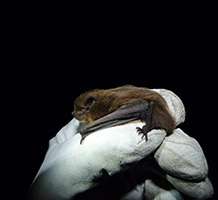Bat's sea crossing is first from UK to mainland Europe

(Phys.org) —A tiny bat found in the Netherlands is believed to provide the first direct evidence that British bats migrate over the sea between the UK and mainland Europe.
The bat, a Nathusius' pipistrelle, flew from Blagdon near Bristol across the country and over the North Sea before settling in a farm building near the coast in Friesland – a direct journey of 596 kilometres (370 miles).
Bat experts in both countries are working together to learn more about this remarkable journey and its implications for bat conservation and offshore windfarms.
A miniature identity ring had been attached to the creature in 2012 by local bat worker, Daniel Hargreaves, as part of research into the ecology of British bats led by Dr Fiona Mathews of the University of Exeter.
Sadly, when the bat was found on December 23 by a wildlife monitor checking the roosting site in Holland, it had already died.
But the discovery of the mammal, which is about the size of a human thumb, is proof that they do successfully migrate across the North Sea.
The movements of Nathusius' pipistrelles both around the UK and between the UK and the continent are currently a mystery. They are elusive creatures, and are too small to carry devices such as satellite trackers used to monitor bird migration.
Mr Hargreaves, who ringed the bat back in 2012, said: "We have hypothesised for a long time about the migration of bats to and from the UK but it's very difficult to prove. This finding was a great surprise and is helping us to understand the huge journeys these bats can make. It's incredible to think that this little bat has flown a distance of at least 600km, avoiding hazards like roads and wind turbines."
The researchers say the discovery raises concerns about the threat of offshore wind farms to migrating bats.
Dr Fiona Mathews of Biosciences at the University of Exeter, who leads the national Bats and Wind Turbines project said: "Nathusius's pipistrelle is one of the species most at risk from land-based wind turbines throughout Europe. We now urgently need to identify the migration routes they use to cross the sea between the UK and continental Europe – offshore wind farms in the wrong place could be very bad news."
"In the autumn, we installed bat detectors on board Brittany Ferries crossing to and from South-West England. We are analysing the data to find out when and where bats are recorded at sea, and clearly now need to extend these surveys to include The North Sea. With so much water to cover, finding bats offshore is a bit like looking for a needle in a haystack. There are some very old historical records made by ships' captains of flocks of bats at sea: what we now need to find out is whether bat migration is a regular event and what routes they take."
Lisa Worledge of the Bat Conservation Trust added: "The timings of peaks in Nathusius' pipistrelle recordings in spring and autumn, as well as records from North Sea oil platforms, have long suggested that some of these bats migrate. This discovery provides the first direct evidence that a British bat migrates over the sea between the UK and continental Europe."
Dr Mathews will now analyse samples from the bat in an attempt to establish whether it originated in the UK or the Netherlands, and whether it had only recently arrived or had spent the summer there.
Provided by University of Exeter


















